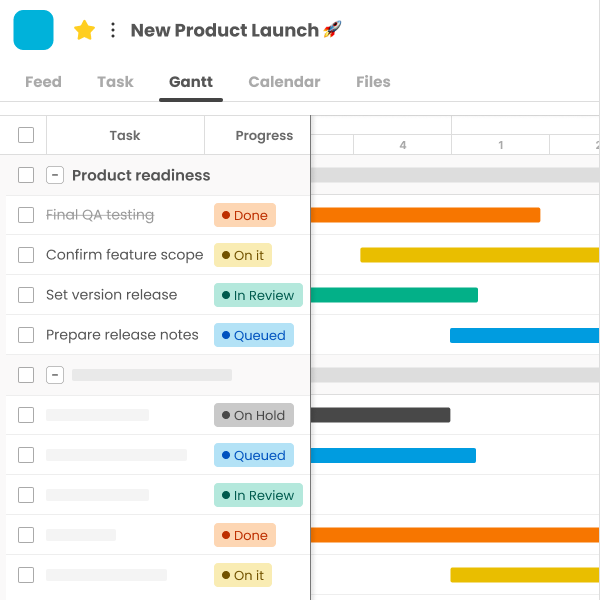Project milestones are essential checkpoints that guide teams through complex projects, highlighting significant achievements and helping to keep initiatives on track. By understanding what milestones are and how to create effective agendas for each one, you can significantly enhance your project’s success and ensure team alignment.
What Is a Milestone in Project Management?
In project management, a milestone marks a key point or event in the project timeline, signifying the completion of a major phase, deliverable, or achievement. Unlike regular tasks, milestones have no duration and serve as indicators of progress toward the project’s ultimate goal.
Milestones help project managers and stakeholders gauge the project’s status at any moment. They provide natural opportunities for assessment, celebration, and necessary adjustments. Think of milestones as signposts on a journey—they confirm that you are moving in the right direction, even if they don’t represent the final destination.
Milestone vs. Task: What’s the Difference?
Understanding the difference between milestones and tasks is crucial for effective project management. Tasks are specific activities that require time, resources, and effort to complete. They have defined start and end dates, involve actual work, and consume project resources.
In contrast, milestones are markers that signify the completion of a group of related tasks or a significant project phase. They do not require additional work beyond what has already been planned and serve solely as checkpoints. For example, “Complete user interface design” is a task, while “UI Design Phase Complete” is a milestone.
Milestone vs. Deliverable
While milestones and deliverables are often confused, they serve different purposes in project management. A deliverable is a tangible output or result that the project must produce—such as a report, software feature, or marketing campaign. Deliverables represent the actual work products that provide value to stakeholders.
Milestones indicate the completion or approval of these deliverables. They mark the moment when a deliverable is finished, reviewed, and accepted. For instance, the deliverable might be “Marketing Strategy Document,” while the milestone would be “Marketing Strategy Approved.”
Why Milestones Matter in Projects
Milestones offer several critical benefits that make them vital for successful project management. They create accountability by establishing clear expectations and deadlines that teams must meet, helping to prevent scope creep and keeping everyone focused on priority objectives.
Milestones also enhance communication with stakeholders by providing easily understood progress indicators. Instead of explaining complex task completions, project managers can simply report milestone achievements, making status updates more accessible to non-technical stakeholders.
How to Create Agendas for Each Milestone
Creating structured agendas for milestone meetings ensures that these important checkpoints fulfill their purpose of assessment, alignment, and planning. An effective milestone agenda transforms a routine status meeting into a strategic session that drives project success.
What Is an Agenda for a Project Milestone?
An agenda for a project milestone is a structured plan that outlines the topics, activities, and discussions for a milestone meeting or review session. This agenda serves as a roadmap, ensuring that all critical aspects of the milestone are systematically addressed.
Typically, the agenda includes a review of completed work, an assessment of milestone criteria, discussions of challenges and risks, celebrations of achievements, and planning for the next phase. It provides a framework that keeps the meeting focused and productive, ensuring that nothing important is overlooked.
How Agendas Improve Milestone Effectiveness
Well-crafted agendas significantly enhance the value of milestone meetings by providing structure and focus. They ensure that all stakeholders come prepared with the necessary information and materials, reducing wasted time and improving decision-making quality.
Agendas also create consistency across milestone meetings, making it easier for participants to understand expectations and prepare accordingly. This consistency helps build momentum and maintain engagement throughout the project lifecycle.
Sample Agenda Structure for a Milestone Meeting
An effective milestone meeting agenda should follow a logical flow from assessment to planning. Start with a brief welcome and milestone overview, then review the completed work against the milestone criteria. Address any issues or concerns that have emerged, celebrate successes, and discuss lessons learned.
The agenda should also include time for risk assessment and mitigation planning, stakeholder feedback and approval processes, and clear next steps with assigned responsibilities. Conclude with a summary of decisions made and action items assigned, ensuring everyone leaves with a clear understanding of their responsibilities.
Key Milestones in Project Management
Recognizing the types of milestones that typically occur in projects helps managers identify the most critical checkpoints for their specific initiatives. Different project phases require different types of milestones, each serving unique purposes in the overall project lifecycle.
Project Initiation Milestones
Initiation milestones mark the formal start of a project and the completion of foundational activities. The “Project Charter Approved” milestone indicates that stakeholders have formally authorized the project and allocated necessary resources. This milestone often includes approval of project scope, budget, timeline, and key personnel assignments.
Another important initiation milestone is “Stakeholder Alignment Achieved,” which signifies that all key stakeholders understand and agree on project objectives, success criteria, and their roles. This milestone helps prevent confusion and conflict later in the project lifecycle.
Planning Milestones
Planning milestones indicate the completion of critical planning activities that will guide project execution. “Project Plan Finalized” marks the completion of detailed work breakdown structures, resource allocation, and timeline development, ensuring that the project team has a clear roadmap for execution.
“Risk Management Plan Approved” represents another crucial planning milestone, indicating that potential risks have been identified, assessed, and mitigation strategies developed. This milestone helps ensure that the project team is prepared for potential challenges.
Execution & Monitoring Milestones
Execution milestones mark significant progress during the active work phase of the project. These might include “Phase 1 Development Complete,” “User Testing Completed,” or “Quality Assurance Passed.” These milestones help maintain momentum and provide opportunities for course correction.
Monitoring milestones focus on project health and performance, such as “Budget Review Complete” or “Schedule Assessment Finished.” These milestones ensure that the project remains on track and within approved parameters.
Closing Milestones
Closing milestones signify the formal completion of project activities and the transition to operational status. “Final Deliverable Accepted” indicates that stakeholders have reviewed and approved the project’s primary outputs. “Project Documentation Complete” ensures that all necessary documentation has been created and stored appropriately.
“Lessons Learned Documented” is a crucial closing milestone that captures valuable insights for future projects, helping organizations improve their project management capabilities over time.
How to Create a Milestone Schedule
Building an effective milestone schedule involves careful planning that aligns with your project goals and the needs of stakeholders. A well-designed milestone schedule serves as a roadmap for tracking progress and sustaining project momentum.
Step 1: Identify Key Project Phases
Start by dividing your project into major phases that represent significant work segments. These phases should group related activities that lead to meaningful outcomes. Typical phases include initiation, planning, design, development, testing, and deployment.
Think about the natural progression of your project and pinpoint moments where important decisions or approvals are necessary. These decision points are ideal for establishing milestones.
Step 2: Define Milestones Within Each Phase
Within each phase, identify the key completion points that deserve milestone status. Focus on outcomes that are measurable, important to stakeholders, and clearly indicate progress toward project goals.
Be cautious not to create too many milestones, as this can lead to unnecessary administrative work without adding value. Aim for 5-10 major milestones for most projects, adding sub-milestones for complex phases if needed.
Step 3: Set Milestone Deadlines
Set realistic deadlines for each milestone based on the work required to achieve them. Consider dependencies between milestones and allow sufficient time for review and approval processes.
Include buffer time for unexpected delays, especially for milestones that rely on external approvals or resources. This buffer helps maintain your schedule’s integrity when challenges arise.
Step 4: Assign Owners and Stakeholders
Clearly assign ownership for each milestone, designating who is responsible for ensuring its completion and who needs to be involved in the review or approval process. This accountability ensures that someone is actively managing progress toward each milestone.
Identify all stakeholders who should participate in milestone meetings or reviews, ensuring the right people are engaged at the appropriate times throughout the project.
Real-World Milestone Examples and Agenda Templates
Practical examples illustrate how milestone agendas function in real projects. These templates can be adapted for various project types and organizational contexts.
Website Redesign Project Milestone Agenda Example
For a website redesign project, a “Design Approval” milestone agenda might include: reviewing design mockups against original requirements, gathering stakeholder feedback on visual elements and user experience, assessing technical feasibility, verifying brand compliance, and outlining the approval process for moving to the development phase.
The agenda would also cover any requested design changes, the timeline impacts of modifications, resource allocation for the development phase, and a communication plan for announcing the design direction to broader stakeholders.
Product Launch Milestone Agenda Example
A product launch milestone agenda for “Pre-Launch Readiness” might include: final product testing results and quality assurance sign-off, review and approval of marketing materials, completion of sales team training, readiness of distribution channels, preparation of customer support, and confirmation of the launch timeline.
Additional topics could include risk assessment for launch activities, contingency plans for potential issues, success metrics and measurement plans, and procedures for post-launch monitoring.
Marketing Campaign Milestone Agenda Example
For a marketing campaign, a “Campaign Assets Complete” milestone agenda could include: review and approval of creative assets, verification of messaging consistency, confirmation of target audience alignment, media placement confirmation, setup of tracking and measurement, and legal compliance verification.
The agenda would also address budget status and allocation, timeline confirmation for the campaign launch, team responsibilities and handoffs, and performance monitoring protocols.
Common Mistakes in Milestone Planning and How to Avoid Them
Identifying common mistakes in milestone planning allows project managers to create better strategies and prevent problems that could affect the success of a project.
Adding Too Many or Too Few Milestones
A common mistake is creating either too many milestones, which leads to administrative burdens, or too few, which hampers progress tracking. The right number of milestones depends on project complexity, duration, and stakeholder needs.
Focus on milestones that signify substantial progress or decision points. If you find yourself creating milestones for routine tasks, you may have too many. Conversely, if months pass between milestones, consider adding more checkpoints.
Misalignment with Deliverables or Timeline
Another frequent error is establishing milestones that do not align with actual deliverables or realistic timelines. Milestones should reflect the completion of meaningful work that delivers tangible value.
Ensure that each milestone corresponds to specific deliverables or outcomes that can be objectively measured. Avoid setting milestone dates that overlook the actual work required or the dependencies involved.
Skipping Milestone Reporting or Reviews
Many projects set milestones but neglect proper reviews or reporting when they are reached. This reduces milestones to mere calendar entries rather than meaningful checkpoints.
Establish clear processes for milestone reviews, including participant roles, required information, and decision-making procedures. Prioritize milestone meetings and ensure that relevant stakeholders actively participate.
Tools to Manage Milestone Agendas and Schedules
Modern project management tools offer powerful features for managing milestones and creating effective agendas. These tools streamline the milestone management process and enhance communication with stakeholders.
Popular platforms like Morningmate, Asana, Trello, and Monday.com provide milestone tracking features that integrate with overall project planning. These tools enable project managers to set milestone dates, assign responsibilities, and automatically track progress.
More advanced tools like Microsoft Project, Smartsheet, and Wrike offer sophisticated milestone scheduling capabilities, including dependency management, resource allocation, and automated reporting. These tools are especially valuable for complex projects with multiple interdependent milestones.
For managing milestone meetings, tools like Notion, Confluence, or even simple Google Docs can help create and maintain milestone agenda templates. These tools allow teams to standardize their milestone review processes and ensure consistency across projects.
The key is to select tools that match your project’s complexity and your team’s needs while providing the necessary functionality to manage milestones effectively. The best tool is one that your team will consistently use throughout the project lifecycle.
Ready to implement effective milestone management in your projects? Start by identifying your next project’s key phases and creating your first milestone schedule using the frameworks outlined in this guide. Remember that successful milestone management requires consistent application and continuous refinement based on your team’s experience and project outcomes.



